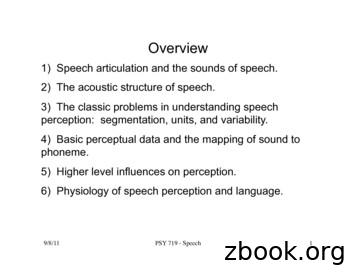An Introduction To Speech Writing
W 397 TALK TO ME An Introduction to Speech Writing James Swart, 4-H Extension Graduate Assistant MANAGEMENT OF APHIDS AND BYD IN TENNESSEE WHEAT 1
Tennessee 4-H Youth Development Talk to Me! An Introduction to Speech Writing Skill Level Beginner Learner Outcomes The learner will be able to: Identify the three main parts of an informational speech. Identify a speech topic. Create a strong opening statement for an informational speech. Educational Standard(s) Supported See Supplemental Information Success Indicator Learners will be successful if they: Identify a topic for their speech. Construct a strong opening statement for their speech. Time Needed 30 minutes Materials List Copies of Hamburger Model Handout for Public Speaking. Parts of a Speech Presentation. Introduction to Content This lesson focuses on providing students with the basic information on structure for an informative speech. This information can be useful if presented in a club meeting prior to the local 4-H Public Speaking contest. A good follow up to this lesson is “What Did You Say?” which discusses proper delivery of speeches. Introduction to Methodology This lesson begins with an assessment of what the students know about speech structure and what makes a good speech by using Think-Pair-Share as a preassessment tool. Based on the skill level assessed by the Think-Pair-Share, the lesson can be tailored to focus strictly on the areas that the students are lacking. The lesson concludes with a brainstorming session where students are able to write a strong opening statement for their 4-H speech. Authors 3 Swart, James. Graduate Assistant, Tennessee 4-H Youth Development Talk to Me! 2
Terms and Concepts Introduction Informational Speech — A speech that serves to provide information to an audience and is fairly free of opinions. Introduction — The first part of a speech, where the topic is introduced and audience attention is captured. Body — The middle part of a speech, where the information is presented. Conclusion — The end of a speech, where concepts are summarized. Setting the Stage Tips for Engagement Begin by saying, “Today, we’re going to learn about the parts of a speech. But before we jump into that, we are going to listen to one of the most famous speeches in US History: The Gettysburg Address, written by Abraham Lincoln.” Have the following questions for students to consider while watching: What makes this a good speech? Who was he speaking to? What was his main purpose of giving this speech? Show YouTube Clip: youtube.com/watch?v 9TCMHVmNc5w. Based on information gained from the ThinkPair-Share pre-assessment, you can gage how in depth you should go with your explanation of the different parts. Make sure that all students are engaged throughout the lesson. Some may not feel comfortable presenting in front of the whole class, so small group work has been incorporated to allow those students who are less comfortable with large groups to practice. Opening Questions Ask Students “What were some main parts of that speech that you picked up on?” (Students answers will vary but should be guided by the questions you had them consider while watching.) Take a poll of students by posing the following question, “How many of you have ever given a speech before?” Ask some students who have to share in what context the speech was given. Experience Begin by doing a Think-Pair-Share activity with the students. The instructions for Think-Pair-Share are outlined in the supplemental information. This portion of the lesson should take approximately 7 minutes. After sharing has been completed, present PowerPoint on parts of a speech. This should take approximately 10 minutes. Students should fill out the Hamburger Model as you present. After presentation, ask students to begin brainstorming about possible 4-H speech topics. They can work independently or in a group to discuss and share ideas. Let them brainstorm for about 3-4 minutes and then ask the students to decide on a topic. After a topic has been chosen, show this YouTube Clip on how to make an effective hook. youtube.com/watch?v nWk0wDnSqv8 Say to students, “One of the most important parts of an effective speech is to grab your audience’s attention. In the next 3 minutes and 23 seconds, I want you to come up with the most exciting opening sentence you can on your topic.” Allow students to write their opening statements, and then ask them to form groups of four to five. Within the groups, each student should present their opening statement and the group should choose a winner. The winners will then present their statements and the class will choose who has the most exciting opening statement. Talk to Me! 3
Share Ask students, “Who can remind me of one of the three parts of an informative speech?” Choose three students to each share one part; answers should be Introduction, Body and Conclusion. Select other students and ask them “What information should be included in each of those parts?” Intro — Introduction of topic and brief overview of presentation. Body — Information on topic presented in orderly fashion. Conclusion — Summary of information presented in body. Life Skill(s) Fourth Grade Participate in 4-H club meetings by saying pledges, completing activities and being engaged. Identify at least four project areas to consider as a project area for future 4-H work Fifth Grade Process Ask students, “Why is it important that we follow this structure when presenting a speech?” (Answers will vary, but they could include makes the speech easier to follow, presents information in a logical fashion, makes it easier to write, etc.) Generalize Participate in 4-H club meetings by saying pledges, completing activities and being engaged. Speak clearly and effectively in group settings Take a poll of students on what their speech topic is. Have them raise their hand by what category it falls into. Possible categories include 4-H, Animals, Favorite Activities and Famous People. Apply Based on time, students can break into groups based on similar topics and discuss what type of information they would need to include in each section of their speech. If time is running out, have students share with the whole class. A good prompt for this question would be “Now that we know the basic structure of an informative speech, brainstorm on what should be included in each of those areas for your topic.” Talk to Me! 4
Supplemental Information Think-Pair-Share Pass out markers or colored ink pens to students. Each student should have a different color than his or her neighbor. To begin, ask students to take out a piece of paper and write down what they think is important when writing a speech. This activity should be done completely on their own. After 2 minutes, ask students to pair off and switch markers with their partner, which should be a different color than their first marker. Ask the pairs to then share information with each other and write down any important information they missed on their individual work. After groups have shared with each other, have students swap markers again, resulting in the students having another different color. Now, ask the class to share what they listed on their lists. If students missed any important information, they should write it on their paper as the class shares. Educational Standards Addressed Fourth Grade Standards: ELA-W.1a: Introduce a topic or text clearly, state an opinion, and create an organizational structure in which related ideas are grouped to support the writer’s purpose. ELA-W.1b: Provide reasons that are supported by facts and details. ELA-W.1d: Provide a concluding statement or section related to the opinions presented. ELA-W.2b: Develop the topic with facts, definitions, concrete details, quotations, or other information and examples related to the topic. ELA-SL.4: Report on a topic or text, tell a story, or recount an experience in an organized manner, using appropriate facts and relevant, descriptive details to support main ideas or themes; speak clearly at an understandable pace. ELA-L.3a: Choose words and phrases to convey ideas precisely. Fifth Grade Standards: ELA-W.1a: Introduce a topic or text clearly, state an opinion, and create an organizational structure in which related ideas are grouped to support the writer’s purpose. ELA-W.1b: Provide logically ordered reasons that are supported by facts. ELA-W.1d: Provide a concluding statement or section related to the opinions presented. ELA-W.2b: Develop the topic with facts, definitions, concrete details, quotations, or other information and examples related to the topic. ELA-W.2d: Use precise language and domain-specific vocabulary to inform about or explain the topic. ELA-SL.4: Report on a topic or text, tell a story, or recount an experience in an organized manner, using appropriate facts and relevant, descriptive details to support main ideas or themes; speak clearly at an understandable pace. ELA-L.3a: Expand, combine, and reduce sentences for meaning, reader/listener interest, and style. Programs in agriculture and natural resources, 4-H youth development, family and consumer sciences, and resource development. University of ssee Institute of Agriculture, U.S. Department of Agriculture and county governments cooperating. UT Extension provides equal opportunities in programs and employment.
— A speech that serves to provide information to an audience and is fairly free of opinions. Introduction — The first part of a speech, where the topic is introduced and audience attention is captured. Body — The middle part of a speech, where the information is presented. Conclusion — The end of a speech, where concepts are summarized.
speech 1 Part 2 – Speech Therapy Speech Therapy Page updated: August 2020 This section contains information about speech therapy services and program coverage (California Code of Regulations [CCR], Title 22, Section 51309). For additional help, refer to the speech therapy billing example section in the appropriate Part 2 manual. Program Coverage
speech or audio processing system that accomplishes a simple or even a complex task—e.g., pitch detection, voiced-unvoiced detection, speech/silence classification, speech synthesis, speech recognition, speaker recognition, helium speech restoration, speech coding, MP3 audio coding, etc. Every student is also required to make a 10-minute
9/8/11! PSY 719 - Speech! 1! Overview 1) Speech articulation and the sounds of speech. 2) The acoustic structure of speech. 3) The classic problems in understanding speech perception: segmentation, units, and variability. 4) Basic perceptual data and the mapping of sound to phoneme. 5) Higher level influences on perception.
1 11/16/11 1 Speech Perception Chapter 13 Review session Thursday 11/17 5:30-6:30pm S249 11/16/11 2 Outline Speech stimulus / Acoustic signal Relationship between stimulus & perception Stimulus dimensions of speech perception Cognitive dimensions of speech perception Speech perception & the brain 11/16/11 3 Speech stimulus
Speech Enhancement Speech Recognition Speech UI Dialog 10s of 1000 hr speech 10s of 1,000 hr noise 10s of 1000 RIR NEVER TRAIN ON THE SAME DATA TWICE Massive . Spectral Subtraction: Waveforms. Deep Neural Networks for Speech Enhancement Direct Indirect Conventional Emulation Mirsamadi, Seyedmahdad, and Ivan Tashev. "Causal Speech
An Introduction to Speech Writing . Skill Level Beginner . Learner Outcomes . The learner will be able to: Identify the three main parts of an informational speech. Identify a speech topic. Speaking contest.Create a strong opening statement for an informational speech.
Speech Recognition Helge Reikeras Introduction Acoustic speech Visual speech Modeling Experimental results Conclusion Introduction 1/2 What? Integration of audio and visual speech modalities with the purpose of enhanching speech recognition performance. Why? McGurk effect (e.g. visual /ga/ combined with an audio /ba/ is heard as /da/)
Lecture 1 Introduction to Digital Speech Processing 2 Speech Processing Speech is the most natural form of human-human communications. Speech is related to language; linguistics is a branch of social science. Speech is related to human physiological capability; physiology is a branch of medical science.























